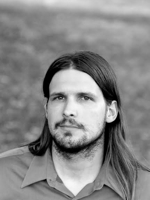Poems by Clinton Crockett Peters
Archives: by Issue | by Author Name

War in the Grand Canyon
by Clinton Crockett Peters
Clint walks his dog along the urban creeks of the Blackland Prairie remnants of North Texas, but he calls home the Llano Estacado Caprock, where the sand-blasted creeks, when they actually have water, feed into the North Fork of The Arms of God River.

We went for Thanksgiving in 2006, cutting class, driving the 18 hours to the South Rim of the world's largest hole in the ground. Eight days we hiked to the Colorado River and back, a conservationist group, pacing, singing, doing yoga, telling Chuck Norris jokes, and cutting down a highly-invasive non-native (Russian) thistle we called Tammy.
Tamarisks. Salt cedars. Evergreens whose niche is low-lying dry areas. It is thought they drown soil with sodium, creating a halo of desiccation, but this seems to have been a misunderstanding. We were 20-somethings, young adults swayed into combat. We went for the excitement, the self-serving, do-gooder mantra of a pilgrimage to bring down an unstoppable invader. Righteous purification electrified us.
We traversed across the canyon, cutting through the red rock shale and scrub, and nudged against cliff faces, staring down a mile. Then we came around a house-sized boulder and beheld a golden and crimson willowing tree that fanned in a light breeze. It was the largest life form in sight, within 15 feet the only life. But it seemed suited to the Southwest, against the backdrop of the canyon and a banded sunrise, earth tone bark, shaggy and sharp.
We sawed Tammies to bloody nubs and doused them in a toxin, for which one needed gloves and face bandana. Otherwise a Tammy, we were told, would grow trunks from its amputation, a Hydra from Siberia.
We slaughtered hundreds of trees in one sub-canyon, ranging in size from finger-thin to one that knuckled around a rock large enough to smash a car. It made a nuisance of itself by growing against a slope, hiding its form. Leaving it was out of the question, as it only takes one stain to darken white sheets again. Eventually, someone cut all the limbs away and burrowed a hole in the trunk, filling it with toxin.
It could spawn clones by the dozens, we were told. But that hardly seemed the point. The effort was, I think, a take-no-prisoners, seek-and-destroy. It was the rhetoric and chemicals from WWII that gave rise to our herbicide industry, after all. Wartime attitudes accompanied those products to the shelf. Enemy, battle, and invader: words used in the armed aggression against unthinking plants in golf courses and canyons. Something that was and is a joy to young 20-somethings, as one of us said, who later shipped off to Afghanistan.
We were covering a landscape with a promise that we were acting beneficially. We had reservations: about the poison, about the fruitless hacking away at a misstep of a prior generation. But it's one of those compromises I run into as I debate using pesticides in my own garden or leave poison out for roaches that melt into my walls. I've found my quest for purity butting up against purity. Pure land, pure water, pure conscience. It’s a fanciful notion. Naive and violence-lusting, purity has led more people down canyons with tools of war than anything. It’s engrained in our culture, but no sage.
We had also packed in two gallons of poison, along with all our gear and food, axes and saws. We might as well have used it. Another kind of purity: the clean slate, waste-not-want not, bottom line. I don’t think the answer here is easy.
As we cut and sheared, Tammy needles began to lie in carpets around our feet, more than a few stuffed down my shirt collar. There was a sea of crimson on top of the gulch we'd been carving. The frail needles became fragments as we marched, dragging trunks and laying them lengthwise on high catches so the river wouldn't rise and let them seed downstream. The fragments became smaller as the hours wore on and our boots munched the needles into ash. As we reached the river bank, having slaughtered all we could, there was a coat of fine powder at our heels, a dust that looked uncannily like a shallow trickle of blood running from the top of the canyon to the raging river below. It was as if a great wound had opened up in the earth, and along its side lay the shattered corpses of Tammies.
I looked back at our destruction, my younger self not satisfied, knowing that in a side canyon over many more invaders waited and that in ten years our work would be erased, as I would, as the world would, forever vexingly impure.
© Clinton Crockett Peters